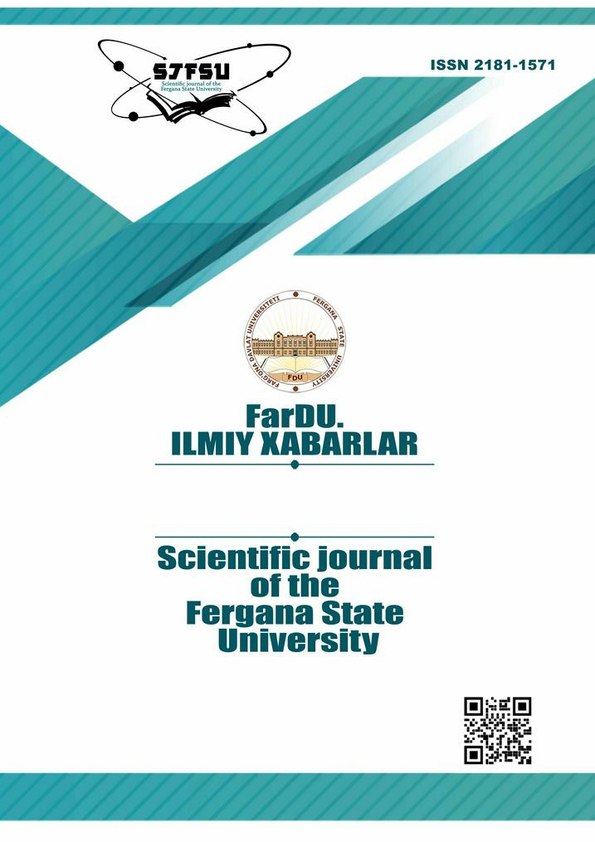INVESTIGATION OF THE MINERAL COMPOSITION OF THE PLANT Prúnus armeníaca L. INDUCTIVELY COUPLED PLASMA MASS SPECTROMETRY
Main Article Content
Abstract
Тhe method of mass spectrometry with inductively coupled plasma was used to study the mineral composition of the plant Prúnus armeníaca L. of the variety "Subkhoniy" growing in the Fergana region. As a result of the analyzes, the qualitative and quantitative content of 26 macro- and microelements in three organs of the plant was determined. The total amount of macronutrients in the leaves is 33825.17 mg/l; in flowers 26311.769 mg/l and in fruits 7570.635 mg/l. The highest content of macronutrients was found for potassium in leaves 22243.325 mg/l and the lowest macronutrient content was found for fruit sodium at 27.972 mg/l. The content of potassium in apricot leaves to the total mass of minerals as a percentage is 65.76%, in flowers 67.7% and in fruits 91.7%. The following trace elements were found in various organs of the plant: Si, Al, Fe, B, Mn, Co, Ni, Cr, Li, Be, and V. Of the toxic elements in the leaves and flowers, 0.001 mg/l of lead was found. Apricot fruits do not contain toxic elements.
Article Details

This work is licensed under a Creative Commons Attribution-NonCommercial-NoDerivatives 4.0 International License.
References
Pollard R.P.; Rhodes L.; Maxted N., Rivers M.C.."Prunus armeniaca". IUCN Red List of Threatened Species.2000: e.T50134200A50134213.
Lu Lingdi; Bartholomew Bruce."Armeniaca vulgaris". In Wu, Z.Y.; Raven, P. H.; Hong, D.Y. (eds.).Flora of China.2003. Vol.9. Beijing & St. Louis: Science Press & Missouri Botanical Garden Press.pp.396–401.
Bourguiba Hedia; Scotti Ivan; Sauvage Christopher; Zhebentyayeva Tetyana; Ledbetter Craig; Krška Boris; Remay Arnaud; D’Onofrio Claudio; Iketani Hiroyuki; Christen Danilo; Krichen Lamia."Genetic structure of a worldwide germplasm collection of Prunus armeniaca L. reveals three major diffusion routes for varieties coming from the species' center of origin". Frontiers in Plant Science.2020.11:638.
Сергиевская Е.В.Систематика высших растений. Практический курс. 2-е изд.СПб.: Лань,2002.С.229—230.
Атлас лекарственных растений СССР/ Гл. ред. акад. Н.В.Цицин. М.:Медгиз,1962.С.2.
Nutritional Composition and Antioxidant Properties of Fruits and Vegetables. Edited by Amit K. Jaiswal. Academic Press. Elsevier, 2020.рр.613-629.
Radi M., Mahrouz M., Jaouad A., Tacchini M., Aubert S., Hugues M., Amiot M.J. Phenolic composition, browning susceptibility, and carotenoid content of several apricot cultivars at maturity. HortScience.1997.32(6),рр.1087–1091.
Dragovic-Uzelac V., Levaj B., Mrkic V., Bursac D., Boras M. The content of polyphenols and carotenoids in three apricot cultivars depending on stage of maturity and geographical region. Food Chem.2007.102(3),рр.966-975.
Расулова М.О., Назаров О.М., Амирова Т.Ш. Определение содержания макро-и микроэлементов в различных видах кожи методом масс-спектрометрии с индуктивно-связанной плазмой. Universum: химия и биология. 2022.6-2(96).С.18-22.
Карабаева Р.Б., Ибрагимов А.А., Назаров О.М.Определение содержания химических элементов и аминокислот в Prunus persica var. Nectarina. Universum: химия и биология.2020. 9 (75).С.15-18.

